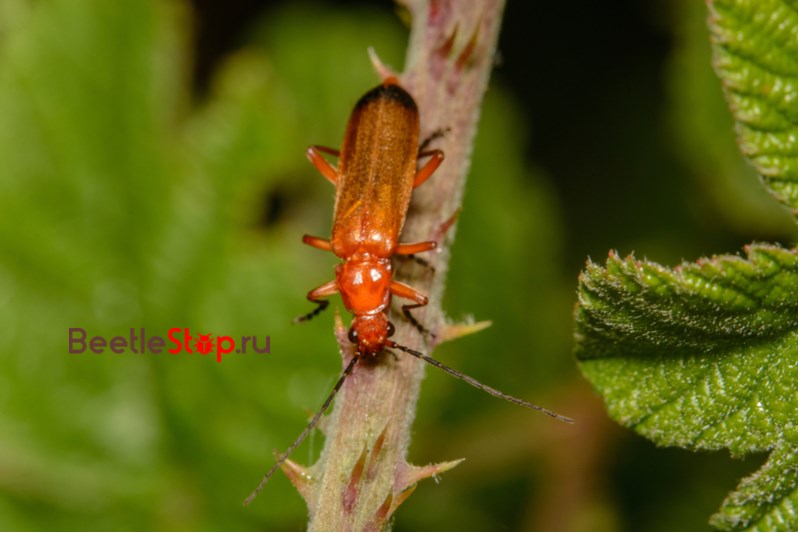Red softcat - orange fighter in the garden
In England, the mobile bright orange beetle is called the "red soldier beetle", in Russia it is known as the soft-bodied red (umbrella). The insect of the family Cantharidae is characterized by a soft cover of the body. Despite their own vulnerability, adult beetles and larvae are ruthless predators. Small invertebrates, flies, aphids become their victims. The soft body repeatedly attacks the prey, biting until it dies. Adults expand their diet by eating flower petals and pollen.

Morphological description of the species
The red soft-body (Rhagonycha fulva) is one of 200 species of soft-body that lives in Russia. Insects of medium size, imago length 7-11 mm. the body is long, flattened, with a soft cuticle. Head and pronot orange or red. On the sides of the head are convex faceted eyes. Antennae long, filiform, composed of 11 segments. The first segment is red, the rest is black. The cover is smooth, shiny with few hairs. Elytra almost completely cover the yellow abdomen. The edge of the hind wings protrudes slightly.
The elytra at the base are red, at the apex there is a wide black stripe. This coloration is an identification characteristic of the species. The elytra is nearly rectangular, with two protruding shoulder tubercles near the scutellum. Surface at small points and hairs. The hind wings are membranous, painted in dark color, attached to the hind thorax. The hips and legs of three pairs of limbs are red, the legs are black. The abdomen consists of 7 segments.
Information. Representatives of the soft body family are settled around the world; the total number of species is 4,500.
Sexual dimorphism
The male soft-body red can be distinguished from the female in size - male individuals are smaller. Females have more developed claws on their legs.
Habitat
The species Rhagonycha fulva is widespread in Europe and Russia. Beetles inhabit the forest, forest-steppe and steppe zone. Habitats are meadows, gardens, overgrown with wasteland, roadside ditches. The red soft-body was introduced to North America and is found in British Columbia and Quebec.
Lifestyle
The absence of chitin in the cuticle makes beetles vulnerable to external influences. Nature took care of protecting the soft bodies, making their hemolymph (blood) poisonous. The orange-red color from afar informs birds and other insectivorous predators of the danger. Adults are active in the daytime. They sit on flowers, waiting for flies, run in dense vegetation in search of aphids, insect eggs, and mealybugs. The beetle has strong jaws, but it does not kill the victim with one blow, but bites several times. Insects covered with chitin in the soft-skinned redhead are too tough, she chooses a simple prey.
The insect years begin in May-June; time depends on the climatic conditions of the region. Beetles are active all summer until September. Thanks to their bright color, they are easy to spot on plants. Insects prefer umbrella crops - cow parsnip, wood bill, wild parsnip, carrots, dill. Adults live on the soil among plants. Here they prey on mollusks and small insects. The species is characterized by frequent mating. Life expectancy is 2-3 months.
Larval development
Fertilized females lay their eggs in the soil, in plant debris, under stones and driftwood. In one clutch of 100-200 eggs.Offspring appear in 1-2 weeks. Their shape is close to the campoids. At the first age, the larvae are deprived of legs, but after molting (after 2-3 days) 3 pairs of limbs appear. Coloring gray-brown, black spots on the thoracic segments.
Information. The larva has a velvety cover of the body; thick short hairs give it such a texture.
The head is dark, flat, with two simple eyes. Antennae short, upper lip absent. Jaws powerful, sickle-shaped. Extra-intestinal digestion is characteristic of soft-body larvae. When bitten, they inject digestive enzymes into the victim’s body. After dissolution of the tissues, the nutritious gruel is sucked out. Larvae lead a secretive lifestyle, hiding in the soil or under stones. For the winter they climb under piles of leaves and tree roots. The development of the larva takes 2-3 years. Pupation takes place in a soil cradle.
Human interaction
In most cases, soft-headed redheads are beneficial insects. Throughout the summer, they destroy pests of the garden and the garden, as well as their eggs and larvae. Beetles are able to clean the house of such unpleasant neighbors as cockroaches. Soft bodies themselves do not penetrate into human housing, they will have to be caught and brought into the room. In the dry season, with significant reproduction, beetles damage the buds of berry and fruit crops. Adults always feed on pollen and flowers of plants, but in small numbers their effect is imperceptible.

